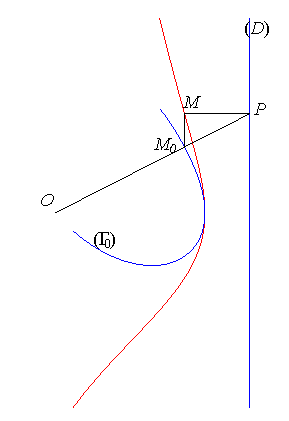| next curve | previous curve | 2D curves | 3D curves | surfaces | fractals | polyhedra |
HYPERBOLISM AND ANTIHYPERBOLISM OF A CURVE
NEWTON TRANSFORMATION
| Notion studied by Newton. |
| Cartesian equation | Cartesian parametrization | |
| initial curve | ||
| hyperbolism with respect to O and the line x = a | ||
| antihyperbolism |
 |
The hyperbolism of a curve Analytically, with the line (D) x = a, the
transformation of |
The inverse transformation ,
is referred to as antihyperbolism.
Examples:
| antihyperbolism | O and (D) (for the initial curve) | O et (D) (for the final curve) | hyperbolism |
| circle | O on the circle, (D) tangent to the circle opposite to O | O on the "middle" of the asymptote and (D) tangent at the summit | witch of Agnesi |
| circle | O centre of the circle, (D) tangent to the circle | O at the centre and (D) tangent at the summit | Külp quartic |
| circle | (D) perpendicular to the line joining O
to the centre of the circle
(this case includes the previous ones) |
Granville egg | |
| circle | O on the circle, (D) parallel to the diameter passing by O | O at the centre and (D) passing by the intersection points with the circle | anguinea |
| lemniscate of Gerono: |
O at the centre, (D) tangent at a vertex | O at the centre, (D) tangent to the circle | circle |
| piriform quartic | O at the cusp, (D) perpendicular to the symmetry axis | O on the circle, (D) parallel to the tangent to the circle at this point | circle |
| rational divergent
parabola: |
O at the centre, (D): x = a | O at the centre and (D): x = a | parabola |
| cubical
parabola: |
O and line x = a | O and line x = a | trident: |
| visiera: |
O and line x = a | O and line x = a | visiera: |
If the straight line (D) is replaced by any given
curve, we get the more general transformation of Newton:
 |
The Newton transform of a couple of curves ( We get the hyperbolism with |
| Cartesian parametrization of the Newton transform of
the curves |
Examples:
| first curve (G1) | second curve (G2) | transform |
| circle with centre O | circle with centre O | ellipse (obtained by "reduction of the ordinates") |
| circle centred on Ox passing through O |
circle with centre O |
eight-like curve |
| swap the previous circles | arc of a parabola | |
| circle centred on Ox | circle with centre O | Hügelschäffer egg |
| next curve | previous curve | 2D curves | 3D curves | surfaces | fractals | polyhedra |
© Robert FERRÉOL 2017